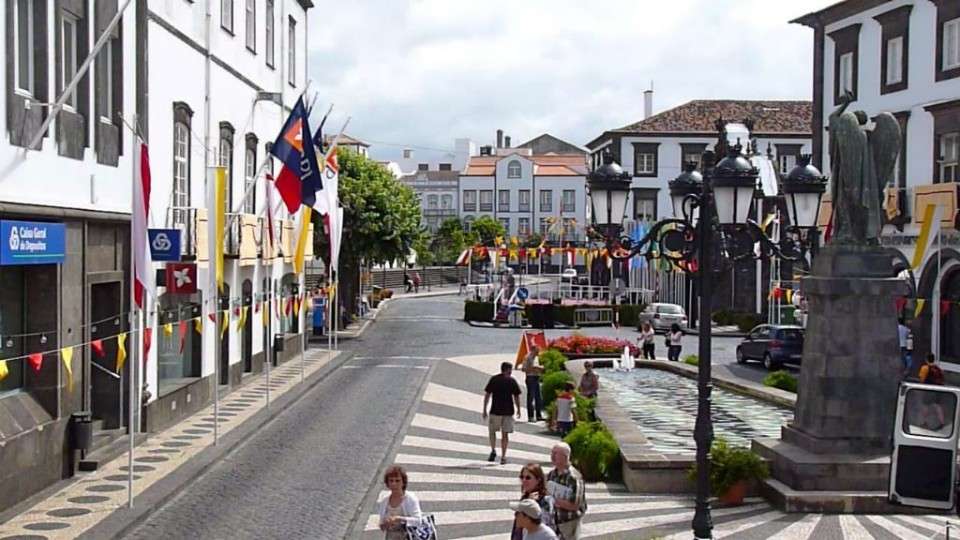Ponta Delgada – Azores
Ponta Delgada, Portuguese for thin point, is the largest municipality and administrative capital of the Autonomous Region of the Azores in Portugal located on the south coast of São Miguel Island, the largest and most populous in the archipelago.
Populated since 1444, the island of São Miguel was a vast territory, with small settlements scattered about.
In 1522 an earthquake and landslide devastated the provincial capital Villa Franca, destroying many of the buildings and killing several people making Ponta Delgada the only centre with an infrastructure to support the Azorean bureaucracy and supplant its important economic links, and eventually, was elevated to the status of city on 2 April 1546.
As part of the 1580 Portuguese succession crisis on 26 July 1582, the naval Battle of Ponta Delgada took place off the coast. An Anglo-French corsair expedition sailed against Spain to preserve Portuguese control of the Azores, thereby preventing Spanish control.
During the 19th century, the municipality experienced its greatest boost of economic activity, with the funnelling of citrus exports to the United Kingdom and the growth of foreign-owned businesses in the historic centre. Ponta Delgada became the third largest town in Portugal, in economic riches and the number of residents.
At the beginning of the 20th century, Ponta Delgada remained the central place in the economy and hierarchy of the Azorean archipelago. Consequently, it was at the forefront of political change following the Carnation Revolution.
Ponta Delgada has a borderline humid subtropical and Mediterranean climate with strong oceanic influence, the climate, much like the rest of the Azores, is shaped by the Gulf Stream allowing a small variation in temperatures. It is well within the subtropical range due to its extremely mild winters.
Ponta Delgada’s Marina is part of the Gateways of the Sea project which includes a cruise ships’ quay, an expanding port for cruise ships and mega-yachts, a pavilion and a hallway of shops. Tourists can go speedboat racing and Big Game Fishing here. The Marina is also known for its pools, including a big natural pool.
Activities such as biking, boating, motorsports, water skiing, surfing, four wheelings, hand gliding, kayaking, white water rafting, yachting, zip-lining, scuba diving, windsurfing, rock climbing, and much more, are enjoyed by locals and tourists. The more adventurous like to go whale watching.
Popular attractions in Ponta Delgada include:
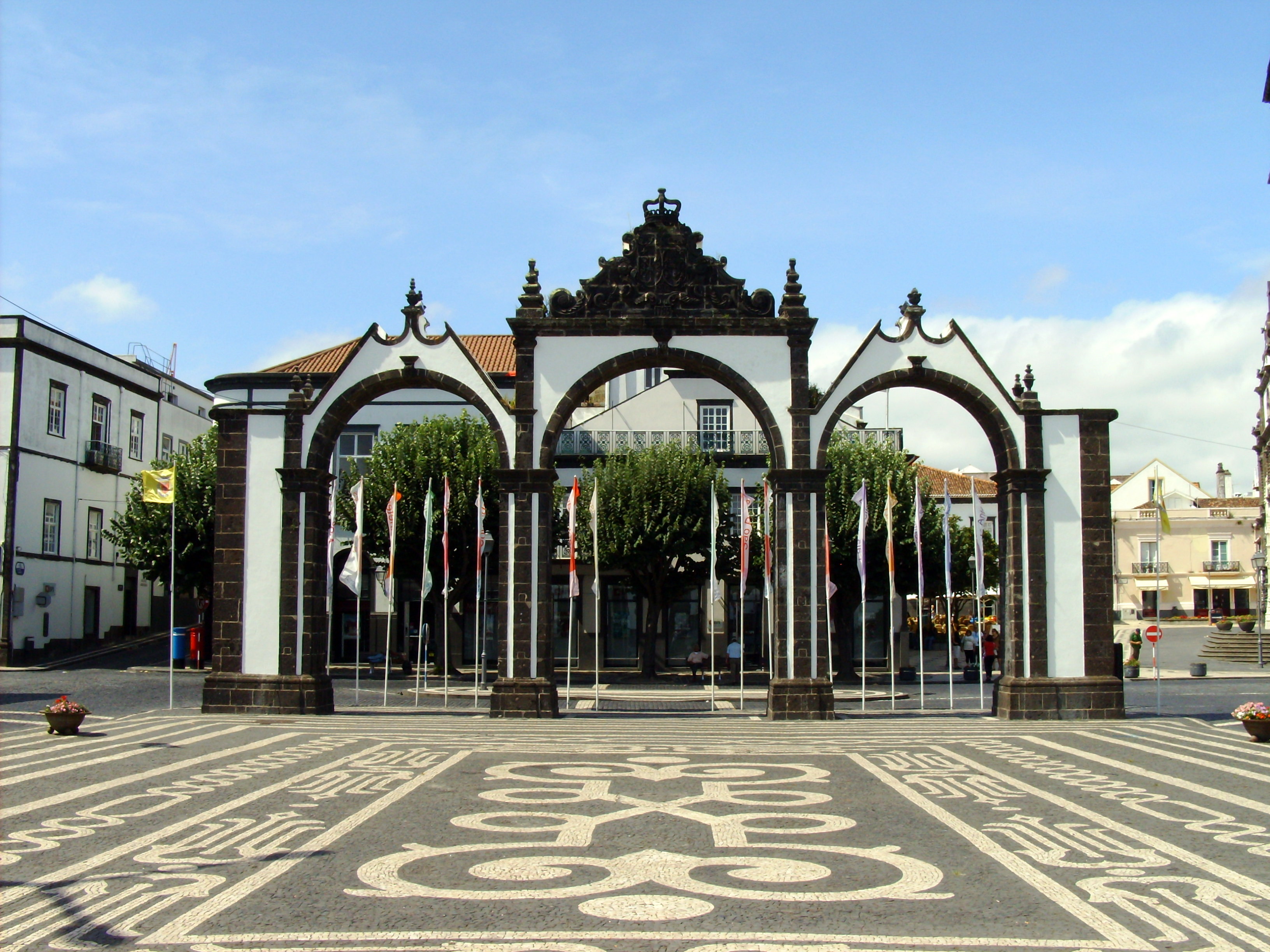
Portas da Cidade
This three-arched gate is Ponta Delgada’s postcard image and appears on the city’s coat of arms. It is part of the old defences and dates to 1783. The gate is made from regional volcanic stone and has whitewashed masonry.
The gate used to be on the quayside but was moved to Gonçalo Velho Cabral Square to stand as a monument when the waterfront avenue was built in the 1940s and 50s.
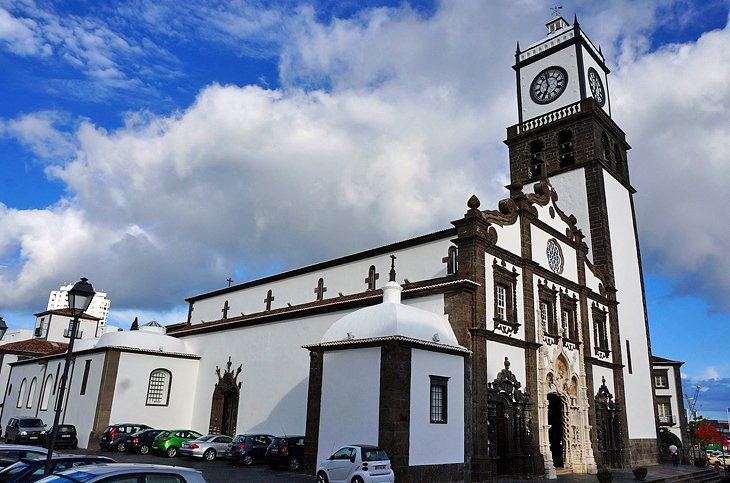
Igreja São Sebastião
Constructed from the black basalt stone that characterizes all public buildings in the Azores, São Sebastião is Ponta Delgada’s parish church. Founded in 1533 originally as a small chapel, the exterior is distinguished by an ornate Manueline portal carved from limestone. During the 18th century, additions in the Baroque style saw a clock tower built and the interior decorated with beautiful azulejo panels. The sumptuous gilded woodwork embellishing the sacristy and most of the furniture was carved from jacaranda and other exotic timber imported from Brazil.

Forte de São Bras
Begun in 1552, this fortress guards the western end of Ponta Delgada’s port and continues to be used as a base by the Portuguese Navy.
A relic from colonial days when Ponta Delgada was under the constant threat of pirate raids. Upper platforms are still equipped with cannons and more modern artillery, while in the bowels of the fort there’s a small military museum with heavy guns, vehicles, uniforms and models spanning almost 500 years.

Carlos Machado Museum
Carlos Machado Museum in the Convento de Santo Andre was created to reflect the scientific mentality of the 19th century. Most of the information is by naturalists of the second half of the 19th century after the publication of Darwin’s Theory of Evolution and the Oceanographic expeditions.

José do Canto Garden
José do Canto was an Azorean landowner and intellectual who distinguished himself as a bibliographer and promoter new agricultural technologies and species into the Azores. He was a renowned gardener and botanist responsible for the creation of a botanical garden, that later bore his name (Jardim José do Canto), in Ponta Delgada.
A cultured wealthy man and a nature lover well versed in the secrets of botany, he established contacts with botanical gardens and nurseries from around the world, from whose he bought, sold or exchanged plants.

Palácio de Sant’Ana – Palácios da Presidência
PALÁCIO DE SANT’ANA – PALÁCIOS DA PRESIDÊNCIA and its park were built by the Morgado José Jácome Correia (first owners of the Palace) and father of the Marquis Jácome Correia, in the mid-19th century in late-baroque architecture.
Since 1978 they house the head office of the Presidency of the Government of the Autonomous Region of Azores.
Classified as a regional monument, its botanical garden is an important living museum and is, as an example of the landscape art of the period, natural and historical heritage.
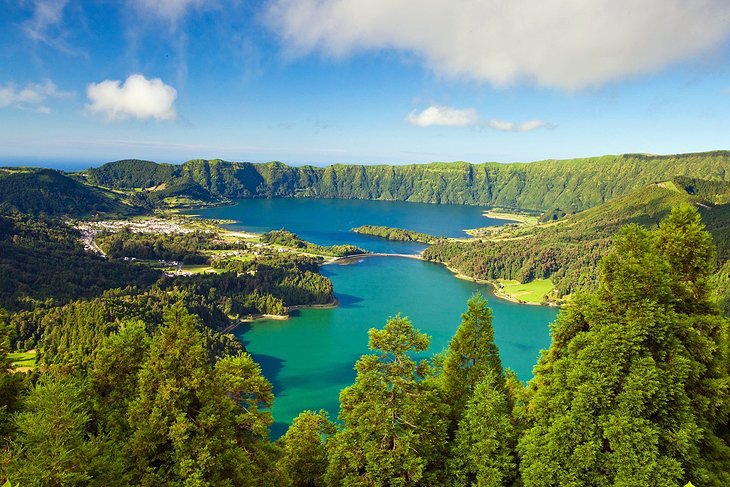
Lagoa das Sete Cidades
Lagoa das Sete Cidades – stunning panorama unveils itself from the Vista do Rei viewpoint, named from King Carlos’s visit in 1901, where both lakes can be admired.
Approximately 26 kilometres west of Ponta Delgada the spectacular volcanic caldera (crater) lake of Lagoa das Sete Cidades is one of the great natural wonders of the Azores archipelago.
On the northwestern tip of São Miguel, the “Lake of Seven Cities” is nearly five kilometres in length, two kilometres wide and roughly 12 kilometres in circumference, this is the largest freshwater lake in the Azores and consists of two lagoons – Lagoa Azul, the Blue
In some places, the cliffs drop 500 meters into the mirror-like waters. The pretty village of Sete Cidades lies on the crater floor and can be reached by crossing the road bridge that divides the two lakes.

Ponta da Ferraria
What makes the hot springs at Ponta da Ferraria unique is where the water comes from: the termas of Ferraria is in the ocean. At Ferraria, the contours of São Miguel’s rocky western shore form a well-known piscina, or natural swimming pool, sheltered by basalt crags and fed by a set of hydrothermal vents.
The cold water of the Atlantic mixing with the natural heat of the shoreline’s volcanic fissure to create a thermal pool.
The warm water is also diverted to feed the private pools at the nearby Termas da Ferraria – spa and bathing site with therapeutic water springs that have been used since the fifteenth century.
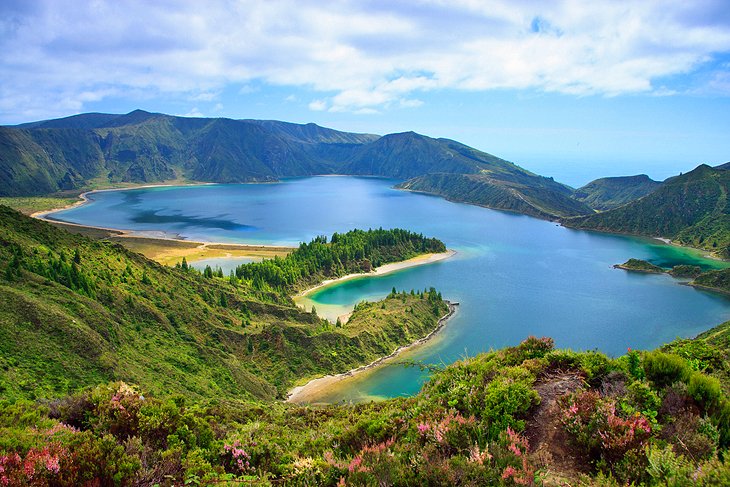
Lagoa do Fogo
Approximately 25 kilometres east of Ponta Delgada the “Lake of Fire” is a breathtaking caldera with a lake at the bottom.
A remote setting, more or less in the middle of São Miguel Island, the area is a protected nature reserve, and the crater’s walls are studded with a number of endemic plant species.
This lake-filled caldera was created by an eruption in 1563, explaining the name “Lake of Fire”. The cobalt lake, measuring one by two kilometres, is in a crucible of green basalt mountains and the highest on the island.
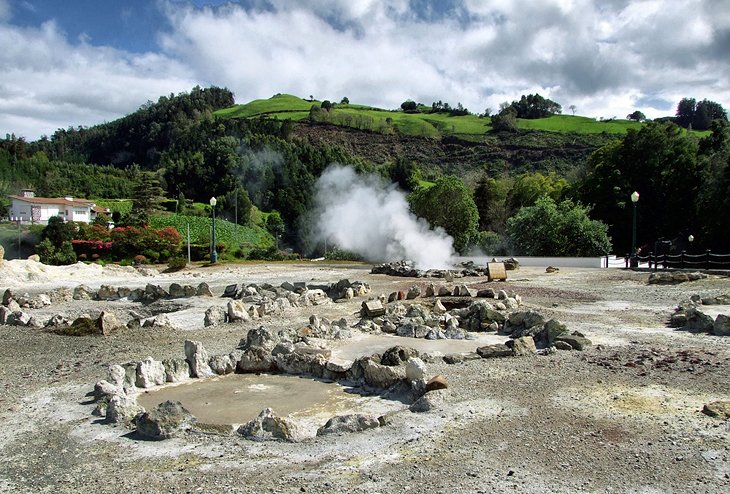
Furnas and the Caldeiras das Furnas
Home of the lake and parish of Furnas, the valley’s typical smell of sulphur and the boiling, smoking hot springs are secondary evidence of volcanic activity.
Valley of Furnas is a hotspot of geological activity, which is, in fact, a huge volcanic crater, first became popular in the 18th century thanks to growing interest in the healing power of the mineral-infused water.
With its gushing geysers, burping mud, and hot bubbling springs, the spa resort of Furnas positively trembles with geothermal activity. A historically active volcanic complex, Furnas embraces a small village, a renowned spa facility, the verdant Parque Terra Nostra, and the impressive Lagoa das Furnas, the second largest lake on São Miguel. There’s been a functioning spa here since the 19th century, patients flock to its doors seeking remedies for skin complaints or hoping to alleviate tired and aching muscles.
There are dozens of hot springs, or fumaroles, dotting the landscape, gaping holes of boiling mineral waters that emerge from the ground, gasping and hissing and emitting a sulphurous, iron-laced vapour.
The northern shores of the Lagoa das Furnas, about two kilometres south of the village, are so hot that islanders come here to cook the famous Cozido nas Caldeiras – a rich meat and vegetable stew. The ingredients are placed in a sealed pot and lowered into a hole in the ground and left to cook slowly for up to seven hours.
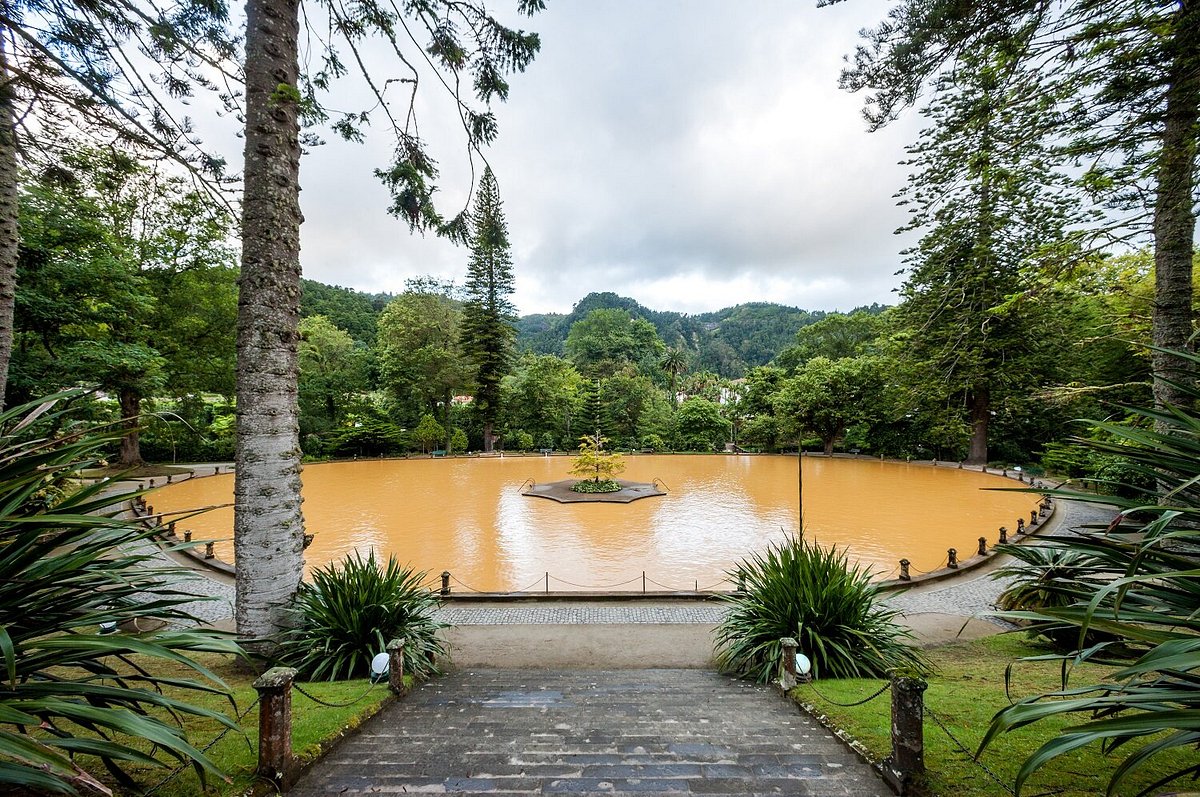
Terra Nostra Park
Roughly 45 kilometres west of Ponta Delgada is one of the most beautiful gardens in Europe, it features a thermal swimming pool and more than 2,000 different trees. The pool at Terra Nostra is the largest and most famous; built-in 1780 by a wealthy American ex-pat and enlarged in 1935, it forms the centrepiece of a subtropical garden.
The thermal pool at Terra Nostra Garden in Furnas doesn’t look particularly appealing at first sight. But don’t let the murky brown colour put you off – it comes from the iron dissolved in the water gushing from a volcanic spring at 35C to 40C, the perfect temperature to ease sore limbs.
The Furnas Valley became popular towards the end of the 18th century, due to the growing interest in the use of mineral water to treat health problems, such as rheumatism and obesity. Furnas has hundreds of small springs and streams, all with different properties. The Terra Nostra Garden is located in the midst of this magnificent water system.



